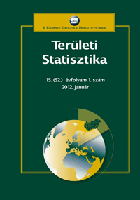Átrendeződés? Kárpátaljaiak Magyarországon, magyarok Kárpátalján, a 2017-ig terjedő adatok tükrében
Realignment? Transcarpathians in Hungary, Hungarians in Transcarpathia in the light of data up to 2017
Author(s): Dávid Karácsonyi, Áron KincsesSubject(s): Social Sciences, Economy, Geography, Regional studies
Published by: Központi Statisztikai Hivatal
Keywords: Ukraine; Transcarpathia; Hungarians; migration; circulation
Summary/Abstract: Population movements following the regime change made it clear that the demographic processes of the Hungarian speech community– despite its fragmentation in 1918 and the nearly 100 years of 'disintegration' – can only be understood as a unified process. Everything taking place in Hungary is just a part of the demographical processes of the Hungarian speech community, but it is not identical with it. Migration from Ukraine to Hungary and the situation of Hungarians living in Ukraine and Transcarpathia are gaining more and more attention in Hungary, and the eastern Ukrainian war, which broke out in 2014, drew attention to Ukraine, extending it to the spheres of science,politics, press and public debate. In addition to analyzing detailed settlement data of Ukrainian citizens, the main objective of our study is to determine whether the conflict that has been going on since 2014, or the economic difficulties in Ukraine in general,or the enticing influence of Hungary play a decisive role in this process. According to our research, the close to 50 thousand multitude from Transcarpathia,showing up in official Hungarian statistics between 2001 and 2017 does not represent a similar migration loss for the Transcarpathian Hungarians. Not all of these people are Hungarians, and beside the “assimilation” profit of about 17.000 for Hungary, the number of participants in the circular migration between the two countries is also 17.000. They have dual addresses and are equally present in both countries. The reason behind this is, in addition to increasing cross-border mobility and informal economy, which improves the resilience of the Transcarpathian community (and thus their chances of staying in their native land), that many people may also benefit from the higher level Hungarian health care system and pensions, or they may take their high-school final examination in a close to the border public education institution in Hungary. According to our conclusion, the Transcarpathian Hungarians actually suffered a migration loss of only 15,000 people in total between 2001 and 2017.
Journal: Területi Statisztika
- Issue Year: 60/2020
- Issue No: 03
- Page Range: 309-351
- Page Count: 43
- Language: Hungarian

